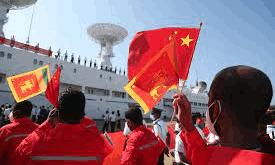Reply To:
Name - Reply Comment
 Sri Lanka is grappling with its most severe economic crisis in history, casting a long shadow over the island nation. The staggering foreign debt, soaring to $46 billion before the 2022 default, coupled with the halting of essential imports, prompted the need for drastic action. As the dust settles and signs of recovery emerge, the intricate puzzle of debt restructuring takes center stage.
Sri Lanka is grappling with its most severe economic crisis in history, casting a long shadow over the island nation. The staggering foreign debt, soaring to $46 billion before the 2022 default, coupled with the halting of essential imports, prompted the need for drastic action. As the dust settles and signs of recovery emerge, the intricate puzzle of debt restructuring takes center stage.
The International Monetary Fund (IMF) extended a crucial $2.9 billion lifeline, but not without crucial strings attached – securing a debt deal with foreign creditors. President Wickremesinghe's government targets April as the deadline for finalizing this process, potentially marking a turning point in Sri Lanka's challenging journey towards financial stability.
China, holding the key to a substantial chunk of Sri Lanka's external debt at 10%, is the elephant in the room. Recent developments provide a glimmer of hope with an "in principle" agreement between China and Sri Lanka. Though shrouded in secrecy, reports suggest extending loan terms and adjusting interest rates rather than outright debt haircuts. While not the ideal outcome for Sri Lanka, it signifies a willingness to negotiate, a crucial step in the right direction.
However, navigating the landscape of international creditors is no easy feat. Japan, the second-largest bilateral lender, expressed confidence in Sri Lanka's recovery trajectory by sending its Finance Minister on a visit. Yet, skepticism persists, particularly among private bondholders, who may be less inclined to compromise.
China's stance on debt restructuring draws both hope and criticism. Some speculate that China, driven by strategic interests in the Indian Ocean region, is playing a longer game with Sri Lanka. Offering loan extensions and interest adjustments instead of definitive haircuts, China might be positioning itself for greater economic and political influence on the island nation.
This cautious approach, while providing temporary relief, could delay Sri Lanka's path to true financial independence and potentially deepen its reliance on Chinese terms. Transparency and clear communication about the agreement's details remain crucial to dispel suspicion and ensure Sri Lanka's debt burden doesn't shift from immediate financial pressure to long-term geopolitical dependence.
Sri Lanka's citizens have borne the brunt of the crisis, enduring months of civil unrest and the painful reality of austerity measures. Tax hikes, subsidy cuts, and rising essential prices have tested their resilience. Wickremesinghe's government, committed to the IMF program, shoulders the immense responsibility of balancing fiscal discipline with citizen well-being.
Adding to the complexity are concerns about transparency and sustainability. The lack of detail surrounding the Chinese agreement breeds uneasiness, with questions swirling about potential hidden pitfalls. Ensuring long-term debt sustainability remains a key challenge, emphasizing the need for the right balance between immediate relief and future stability to avoid falling into another debt trap.
Despite uncertainties, cautious optimism permeates the air. The first quarter of 2024 is a critical juncture. A concrete debt deal with all creditors, followed by diligent implementation, could pave the way for economic revitalization. Modest GDP growth in the September quarter is a promising sign, and the IMF's ongoing mission signals continued confidence in Sri Lanka's recovery efforts.
Sri Lanka's path ahead is challenging, requiring a delicate balancing act in navigating complex creditor negotiations, maintaining fiscal discipline, and addressing citizen needs. Transparency, communication, and long-term planning are essential to ensure debt restructuring isn't a temporary fix but a stepping stone toward a sustainable and prosperous future.
Looking beyond immediate economic challenges, Sri Lanka's crisis offers valuable lessons for developing nations facing similar issues. The perils of excessive debt dependence, the importance of sound economic policies, and the need for international cooperation become starkly evident. As Sri Lanka continues its uphill climb, its experiences can serve as a cautionary tale and a source of inspiration for others navigating the treacherous waters of global finance.
In conclusion, Sri Lanka's debt restructuring saga is ongoing. While glimmers of hope emerge, complex negotiations, internal anxieties, and sustainability concerns linger. Nonetheless, the island nation stands at a crossroads, with the potential to chart a course toward a brighter future.